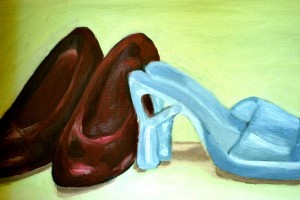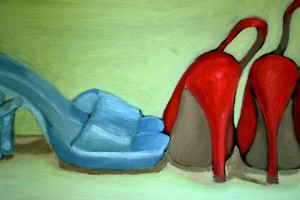Pain over Pedicures
 What I remember most about my senior prom is my shoes. They were sparkly and strappy stiletto heels that were fantastically tall and made my legs look long and lean. I had wandered from store to store throughout the mall until I found them. Unfortunately, their appearance is not the reason why I remember them so clearly; rather, it’s because those high heels were the most excruciatingly painful things I have ever put on my feet. By the end of prom night, I was not even able to walk anymore. The shoes still sit in my closet, never to be worn again, and whenever someone asks me about prom, I always have to emphasize how my heels were the most painful things I have ever worn.
What I remember most about my senior prom is my shoes. They were sparkly and strappy stiletto heels that were fantastically tall and made my legs look long and lean. I had wandered from store to store throughout the mall until I found them. Unfortunately, their appearance is not the reason why I remember them so clearly; rather, it’s because those high heels were the most excruciatingly painful things I have ever put on my feet. By the end of prom night, I was not even able to walk anymore. The shoes still sit in my closet, never to be worn again, and whenever someone asks me about prom, I always have to emphasize how my heels were the most painful things I have ever worn.
However, I know that I am with such a story; women have been inflicting pain on their feet since ancient times because of fashion and societal pressures. The best-known example is the abandoned Chinese tradition of foot-binding. Although no longer practiced, such an idea has not completely been vanquished. Shoes, such as high heels, flats, flip-flops, and even athletic sneakers are a constant source of debate in today’s American society for a variety of reasons, mainly their effect on women’s bodies and sexual objectification.
The origin of foot binding in China is debated. The most commonly agreed upon legend states that foot binding started during the rule of Emperor Li Yu from 961 to 975 AD. He supposedly fell in love with a dancer who bound her feet, and then other women of the court soon adopted this idea as fashionable. Whichever legend is told, it is certain that foot-binding started in the royal courts of China and eventually worked its way to the upper class where it became concretely connected to social status and wealth. From there, the trend worked its way down into the rural communities, where it was enthusiastically adopted as a way for young girls to marry into the upper class and gain prestige for their family.
To have desirably bound feet, the binding had to start at a young age because then the bones were weaker and easier to manipulate. Toes and arches would be broken so that the toes could be bent underneath the foot to the heel. The process was usually done gradually, but once the foot binding had started it was hard return the foot to normal if so desired. Once the foot was bent back enough, it would be bound with a ten-foot-long bandage which would have to be kept on for the rest of one’s life, only taken off every two or three weeks to rebind and wash the foot. The desired effect was a three-inch-long foot, with the toes as close to the heel as possible, creating a narrow “crescent moon” shape.
Foot-binding prevailed for centuries; it did not meet much resistance until 1644 with an attempted ban issued by the Manchu, who were part of the Qing Dynasty. However, the ban was unable to reach to the vast majority of the Chinese people, and instead only affected the small number of Manchu noble women. Foreign missionaries in the 1800’s were the next to express dislike of the tradition, leading to the formation of the first anti-foot-binding committee in Shanghai by a British priest. Once again, however, this did not have much effect on China’s overall population.
When the Qing Dynasty fell and the new Re public of China emerged in 1912, a new ban on foot-binding was immediately issued. This had a greater effect than prior bans, but many women, especially those of lower class, continued to feel societal pressure to have tiny feet. They bound their feet in secret, covering them with oversizedshoes with officials came by the house. Another ban was issued by the Communist government in 1949, and by then young girls were stopping the practice. Although there are a few elderly women left with bound feet in China today, the practice is no longer considered fashionable.
 It can be difficult for many women today to understand why Chinese women put themselves through such a painful procedure for centuries, but unfortunately there were not many other options because of the way society functioned. Foot-binding was a symbol of wealth and it was very hard to find a husband without having bound feet. Not only were little feet considered sexually desirable, but it also gave husbands extremely strong control over their wives. Women were unable to run after their children, leave the house and walk around, engage in sexual freedoms as men often did, or even dance normally. Once the Communist government was in place, women faced even more difficulties because they were unable to perform manual labor, and thus struggled to fulfill daily quotas and provide for their families.
It can be difficult for many women today to understand why Chinese women put themselves through such a painful procedure for centuries, but unfortunately there were not many other options because of the way society functioned. Foot-binding was a symbol of wealth and it was very hard to find a husband without having bound feet. Not only were little feet considered sexually desirable, but it also gave husbands extremely strong control over their wives. Women were unable to run after their children, leave the house and walk around, engage in sexual freedoms as men often did, or even dance normally. Once the Communist government was in place, women faced even more difficulties because they were unable to perform manual labor, and thus struggled to fulfill daily quotas and provide for their families.
The prevalent fashion staple today, the high heel, is not as extreme as foot-binding, but is a similar phenomenon. The two have often been compared throughout the 20th century, because not only have they been shown to cause health problems, but also because they are seen as a way of turning women into sexual objects for men. Also, bound feet and high heels have been historically associated with the upper class. Heels have been criticized for being sexually suggestive ever since the 1700’s; the Puritans even passed a law banning heels, saying they were the shoes of witches. Unlike foot-binding, heels have been connected more to fashion than to culture—they have been in and out of style from decade to decade depending on the economy, social revolutions, and other changes.
Today, although there are many shoe options for women, heels are often considered a necessity for the workplace and for socializing at parties. There is debate over whether heels demean women, placing emphasis on long legs and firm behinds, or whether they help create a positive mental attitude; it is often said that heels give a woman a feeling of power, competence, and high self-esteem.
It is important to realize how detrimental high heels are for one’s physical body, however, especially after long-term use. They affect the ability to run, cause foot deformities and lower back pain, shorten the Achilles’ tendon making it painful to wear flatter shoes, and even cause degenerative joint disease of the knees.
 Other types of shoes are a source of concern too, however. Flip-flops and flats have also been criticized as a cause of health problems because they do not provide enough arch support. Many advertisements for women’s athletic shoes are detrimental to positive body image, as they exhibit models with perfectly toned legs and insist that buying their sneaker will achieve such an effect. One shocking example is the new Reebok advertisement for EasyTone shoes, in which the camera continuously zooms in on the behind of the athletic woman against her wishes.
Other types of shoes are a source of concern too, however. Flip-flops and flats have also been criticized as a cause of health problems because they do not provide enough arch support. Many advertisements for women’s athletic shoes are detrimental to positive body image, as they exhibit models with perfectly toned legs and insist that buying their sneaker will achieve such an effect. One shocking example is the new Reebok advertisement for EasyTone shoes, in which the camera continuously zooms in on the behind of the athletic woman against her wishes.
In this world, I’m finding it hard to trust any pair of shoes. Are they going to give me blisters? Will they make it painful to stand or difficult to walk? Do they have unknown detrimental health effects? Will guys see me only as a sexual object if I wear them? Even if I don’t have all the answers, at least my prom shoes, sitting innocently on my shelf, continue to remind me every day that what fashion tells me looks good is not always what is best for my body.

![[in]Visible Magazine](https://community.scrippscollege.edu/invisible/wp-content/uploads/sites/5/2011/04/Invisible-Masthead-2011-Spring1.png)







No comments yet... Be the first to leave a reply!